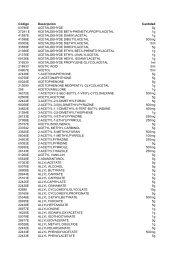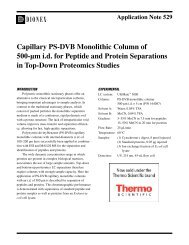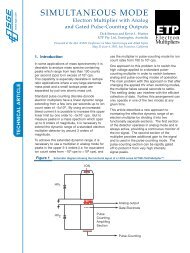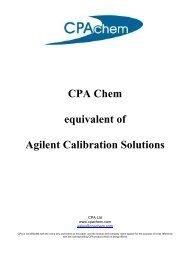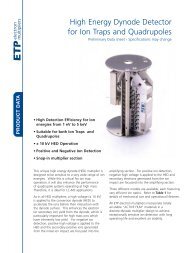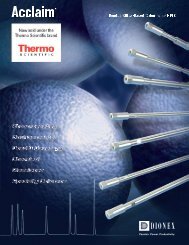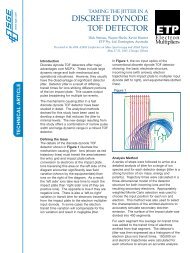Product Manual for Dionex IonPac AS23 Columns - Cromlab
Product Manual for Dionex IonPac AS23 Columns - Cromlab
Product Manual for Dionex IonPac AS23 Columns - Cromlab
Create successful ePaper yourself
Turn your PDF publications into a flip-book with our unique Google optimized e-Paper software.
<strong>Product</strong> <strong>Manual</strong> <strong>for</strong> <strong>IonPac</strong> <strong>AS23</strong> amd <strong>IonPac</strong> AG23 <strong>Columns</strong> Page 9 of 32SECTION 4 - OPERATION4.1 General Operating ConditionsSample Volume:Column:2-mm: 5 μL Loop + 0.8 μL Injection valve dead volume4-mm: 25 μL Loop + 0.8 μL Injection valve dead volume2-mm: <strong>AS23</strong> 2-mm Analytical Column + AG23 2-mm Guard Column4-mm: <strong>AS23</strong> 4-mm Analytical Column + AG23 4-mm Guard ColumnEluent: 4.5 mM Na 2CO 3/0.8 mM NaHCO 3Temperature: 30 °CEluent Flow Rate:2-mm: 0.25 mL/min4-mm: 1.0 mL/minSRS Suppressor:Anion Self-Regenerating Suppressor, ASRS ULTRA II (2-mm or 4-mm)AutoSuppression Recycle Modeor MMS Suppressor:Anion MicroMembrane Suppressor, AMMS III (2-mm or 4-mm)or AES Suppressor:Expected Background Conductivity:Long-term Storage Solution (> 1 week):Short-term Storage Solution (< 1 week):Regenerant is 50 mN H 2SO 4Anion Atlas Electrolytic Suppressor, AAES20-22 μS100 mM Sodium BicarbonateEluent4.2 <strong>IonPac</strong> <strong>AS23</strong> Operation PrecautionsCAUTIONSFilter and Degas EluentsFilter SamplesEluent pH between 0 and 14Sample pH between 0 and 140.5 mL/min Maximum Flow Rate <strong>for</strong> 2-mm <strong>Columns</strong>2.0 mL/min Maximum Flow Rate <strong>for</strong> 4-mm <strong>Columns</strong>Maximum Operating Pressure = 3,000 psi (20.68 MPa)4.3 Chemical Purity RequirementsObtaining reliable, consistent and accurate results requires eluents that are free of ionic impurities. Chemicals, solvents anddeionized water used to prepare eluents must be of the highest purity available. Low trace impurities and low particle levels ineluents also help to protect your ion exchange columns and system components. <strong>Dionex</strong> cannot guarantee proper columnper<strong>for</strong>mance when the quality of the chemicals, solvents and water used to prepare eluents has been compromised.4.3.1 Inorganic ChemicalsReagent Grade inorganic chemicals should always be used to prepare ionic eluents. Whenever possible, inorganic chemicals thatmeet or surpass the latest American Chemical Society standard <strong>for</strong> purity should be used. These inorganic chemicals will detailthe purity by having an actual lot analysis on each label. Occasionally, batches of sodium carbonate are produced with lowconcentrations of residual hydroxide impurity. Use of such reagent can adversely effect the resolution of phosphate and sulfate.Use of <strong>Dionex</strong> <strong>AS23</strong> Eluent Concentrate (P/N 064161) is recommended in order to avoid this problem. Otherwise, use of a high puritygrade of sodium carbonate to prepare eluents will generally prevent the problem. We recommend EMD Chemicals sodium carbonate(P/N SX0395) <strong>for</strong> this purpose. Do not dry sodium carbonate at excessive temperatures (> 110°C) as this will increase the pH of thesalt.Document No. 065120-05 ©2012 Thermo Fisher Scientific July 2012




